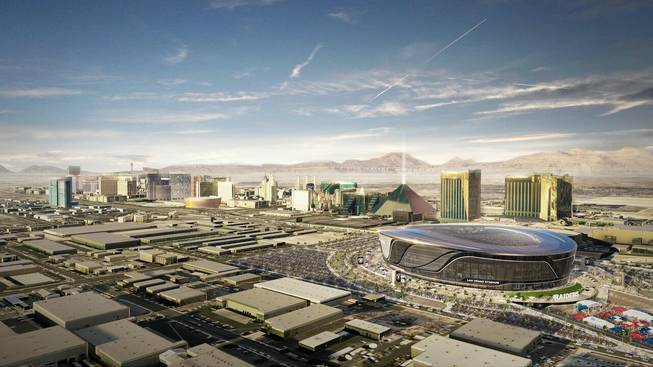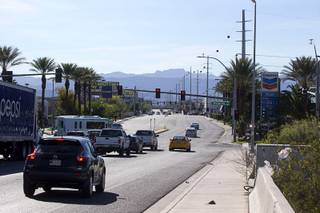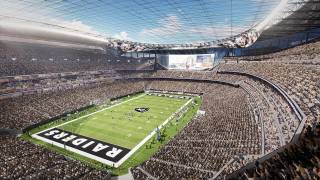
Courtesy of MANICA Architecture
A look at the proposed $1.9 billion domed football stadium for the Oakland Raiders and UNLV football in Las Vegas.
Monday, April 3, 2017 | 2 a.m.
Here come the Raiders.
National Football League owners agreed last week to let the Raiders move from Oakland to Las Vegas. The approval ends a courtship that lasted more than a year, but it also starts a clock on the team’s plans to build a stadium and establish a presence in Southern Nevada.
News about the Raiders and their future flew furiously in recent days, so let’s pause for a moment to sort some myths from realities about Las Vegas’ newest major-league franchise.
Will we be a Super Bowl destination?
The next four Super Bowls will be in Minnesota, Atlanta, Miami and Los Angeles. Not so coincidentally, those cities either recently constructed or renovated stadiums. If you build it, the Super Bowl most likely will come — but not before 2022, the next available date on the NFL calendar.
Fact or fiction? NFL team owners unconditionally approved the Raiders’ move to Las Vegas.
Thirty-one of the NFL’s 32 team owners voted to approve the move, with Miami Dolphins owner Stephen Ross dissenting. The near-unanimous decision indicates that owners felt comfortable with the $850 million in debt the Raiders will incur toward their $1.9 billion stadium, as well as the team’s plan to fill the facility with outside events to generate year-round revenue.
“The support of 31 of 32 owners is a sign of how they think the Raiders have a great opportunity to create something special,” New York Giants co-owner Steve Tisch said.
Raiders President Marc Badain did not disclose what questions league owners asked during the team’s presentation before the vote in Phoenix.
“They were fair questions, they were tough questions,” Badain said. “They’ve been good for the last six to eight months. They want to know that this is the right decision for the franchise ... (and) the league. So they’re going to ask tough questions.”
While owners attached no explicit conditions, multiple NFL sources emphasized that the team’s 30-year lease agreement with the Las Vegas Stadium Authority must be completed in a timely manner to keep the move on track. Badain also declined to comment to reporters on the lease agreement.
“Right now, it’s a process that’s better left not in the public domain,” Badain said.
Las Vegas Stadium Authority board chairman Steve Hill said representatives including Raiders counsel Dan Ventrelle and Stadium Authority staff leader Jeremy Aguero have been in regular contact to discuss outstanding lease issues. The Raiders submitted a draft in January, and both Stadium Authority and UNLV officials responded with questions and concerns.
“My sense is there are some open items for the April (board) meeting,” Hill said. “We’ll bring back a document that I would anticipate would be pretty close.”
Hill said three other documents must be completed as well: a development agreement to build the stadium; a shared-use agreement with co-tenant UNLV; and a nonrelocation agreement with the Raiders. He anticipates the development agreement will take the most time to work through, but that all four contracts will be ratified by the board at once.
Verdict: Mostly fact
Fact or fiction: The Raiders will play games in Las Vegas before the stadium project is completed.
The Raiders have two one-year lease options to play at Oakland Coliseum, for the 2017 and 2018 seasons. The team officially gave notice to the Oakland-Alameda County Coliseum Authority that it would exercise its 2017 lease option, about an hour after the announcement of the relocation approval, according to Coliseum Authority Executive Director Scott McKibben. The team cannot exercise its 2018 option at this point.
McKibben said he did not see any way his side would agree to having the Raiders beyond 2018.
“I don’t believe so, no,” McKibben said. “More important than anything, we want to be able to move on and make plans with either (Major League Baseball’s) A’s on that property, or utilization of that building for other kinds of events or that land for some other kind of development.”
Raiders owner Mark Davis said his first preference remained to play in Oakland in 2019.
“Hopefully when the emotions die down a little bit, we can sit down and talk,” Davis said.
The only potential stopgap for the Raiders in Las Vegas is Sam Boyd Stadium, the 35,000-seat facility on the valley’s eastern edge that hosts UNLV football. Asked if he sees Sam Boyd as a temporary home for his team in 2019, Davis said, “I don’t believe so, to be real honest.”
Badain said it would be “challenging” to upgrade Sam Boyd to NFL standards, but that the team would not close the door entirely on the facility. That could leave open the possibility of playing preseason games in the stadium to give Las Vegas fans a preview of the team.
The most obvious issue at Sam Boyd is its tiny, outdated locker rooms that barely accommodate two college teams. The NFL’s Operations website also details how league games are high-tech affairs requiring significant infrastructure for electronics and telecommunications. For example, coaches can talk on secure radio frequencies directly into the helmets of their quarterback and a designated defensive player during a game.
If the Raiders cannot play in Las Vegas or Oakland in 2019, they might become true nomads. Facilities in San Francisco, Berkeley, Santa Clara, Los Angeles, San Diego and San Antonio surfaced as possibilities in recent reports.
Verdict: Mostly fiction
The stadium must host other events to meet economic projections
After casino magnate Sheldon Adelson withdrew in January his $650 million investment in developing the stadium project, the Raiders took responsibility for acting as the stadium events company mandated by the new state law. The Raiders likely will delegate that responsibility to an established company that will need to attract events like the Super Bowl and Final Four to generate ticket revenue, as well as to fill hotel rooms that provide the tax money behind the public funding.
Fact or fiction: The Raiders will pay $1 per year in rent.
That figure comes from the January lease proposal that drew a great deal of apprehension. Until the next draft emerges at the April 20 board meeting, no one knows how much the team’s rent to the Stadium Authority will be. The Stadium Authority will own both the stadium and the land on which it will stand.
Verdict: Fiction
Fact or fiction: The new stadium will be located just southwest of the Strip on Russell Road.
The Raiders hold an option to purchase the 63-acre site that they greatly prefer for its proximity to the Strip. That would create a short trip for out-of-town visitors, but sources also said being close to the resort corridor could increase the value of naming rights on the facility.
The Russell Road site comes with challenges, though. Clark County Commissioner Steve Sisolak visited the site recently with Badain, and the two looked closely at potential traffic and parking, including the adequacy of the Interstate 15 exit at Russell for heavy use on game day. A study last year showed almost $900 million in I-15 corridor projects already in the planning stages.
“I’ve had numerous concerns that he understands a lot better now,” Sisolak said. “I have major concerns with their No. 1 site as it relates to traffic and parking. We exchanged a lot of information, but we didn’t come to any understandings.”
The Stadium Authority ultimately must ratify the team’s site selection. As the stadium developer, the Raiders will need to purchase the land and transfer ownership of it to the Stadium Authority. This provision exists to protect the $750 million public investment in the stadium if the Raiders were to ever leave.
Verdict: Mostly fact
UNLV’s football team will play all of its home games in the new stadium beginning in 2020
The law passed in October by a special session of the Nevada Legislature authorized $750 million generated by a new tax on hotel stays to help build the Raiders stadium, but with the stipulation that the team must share the facility with UNLV. The Raiders and UNLV have not yet had formal negotiations over how they will function together in the stadium. Hill said recently that he did not anticipate the Stadium Authority approving a lease for the Raiders until an agreement with UNLV was in place. Badain and Davis both called UNLV President Len Jessup after the relocation approval to share the news with their new “roommate,” as Davis joked. “President Jessup has been great from Day One,” Badain said. UNLV officials want to ensure that the team’s fans feel at home in a facility where the Raiders will get top billing. That includes the ability to paint the field with the Rebels’ colors of scarlet and gray, as well as use of premium facilities such as suites and club seating for sponsors and donors.
Does a new stadium mean a new conference for UNLV?
Take a tour of the beautiful and historic stadiums of the Pac-12 conference. The Rose Bowl in Pasadena, Calif. Stanford Stadium near Palo Alto, Calif. Autzen Stadium in Eugene, Ore. The Memorial Coliseum in Los Angeles. Then look at Sam Boyd Stadium.
Sam Boyd has its charms, but it sticks out on that list, and not in a good way. That’s why UNLV’s much-discussed efforts to join a Power 5 conference were boosted when the NFL voted to approve the Raiders’ move to Las Vegas. The city’s sparkling new domed stadium — anticipated to be ready by 2020 — will house the Raiders and UNLV football, clearing a major obstacle as the Rebels continue their pitch to big conferences.
There are other hurdles remaining before UNLV can be taken seriously by the Pac-12, Big 12 or any Power 5 league: Athletic performance tops the list. UNLV needs its basketball and football teams to start winning (and generating revenue) before the school can be viewed as a viable Power 5 candidate.
Now that the stadium is in the bag, it’s up to football coach Tony Sanchez and basketball coach Marvin Menzies, as well as UNLV’s incoming athletic director, to deliver Power 5-worthy products on a regular basis. That’s the best way to ensure UNLV’s survival in a changing NCAA landscape that is becoming increasingly tilted toward schools with big TV contracts and the big athletic budgets that come with them.
Mike Grimala contributed to this report.



Join the Discussion:
Check this out for a full explanation of our conversion to the LiveFyre commenting system and instructions on how to sign up for an account.
Full comments policy